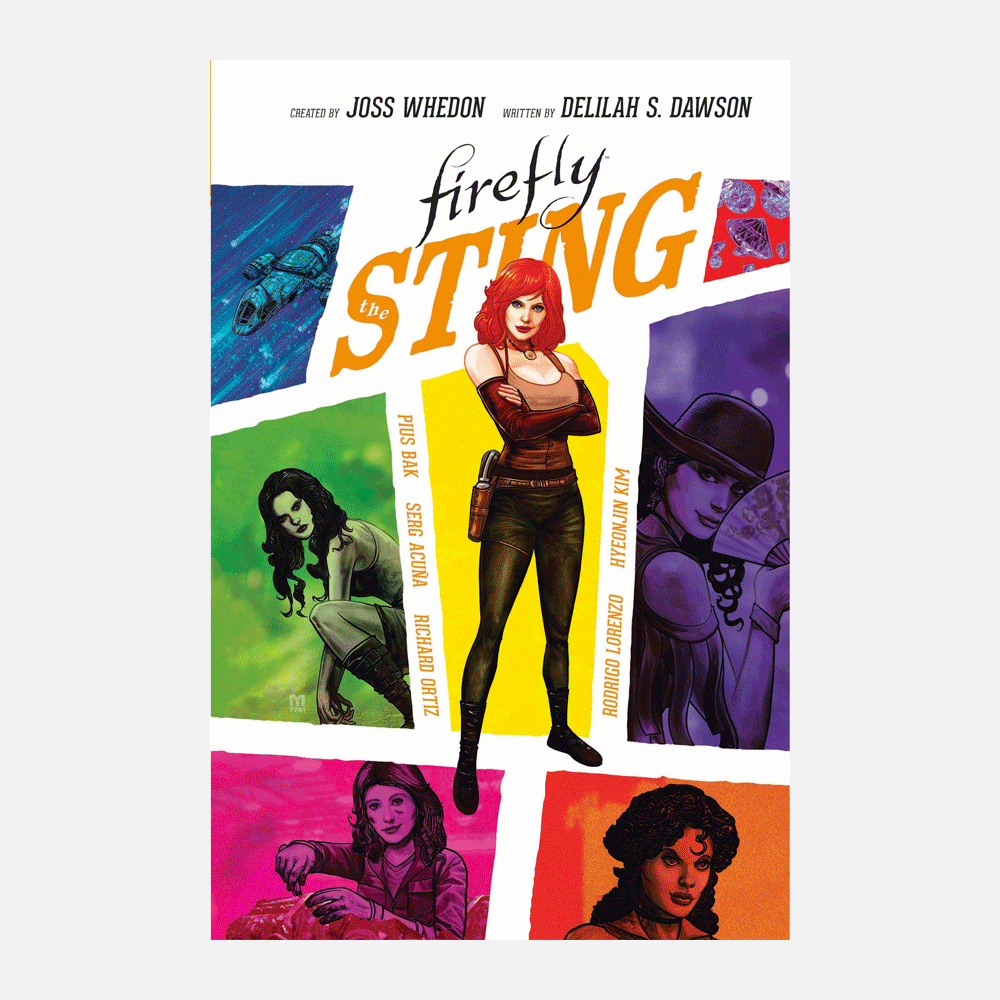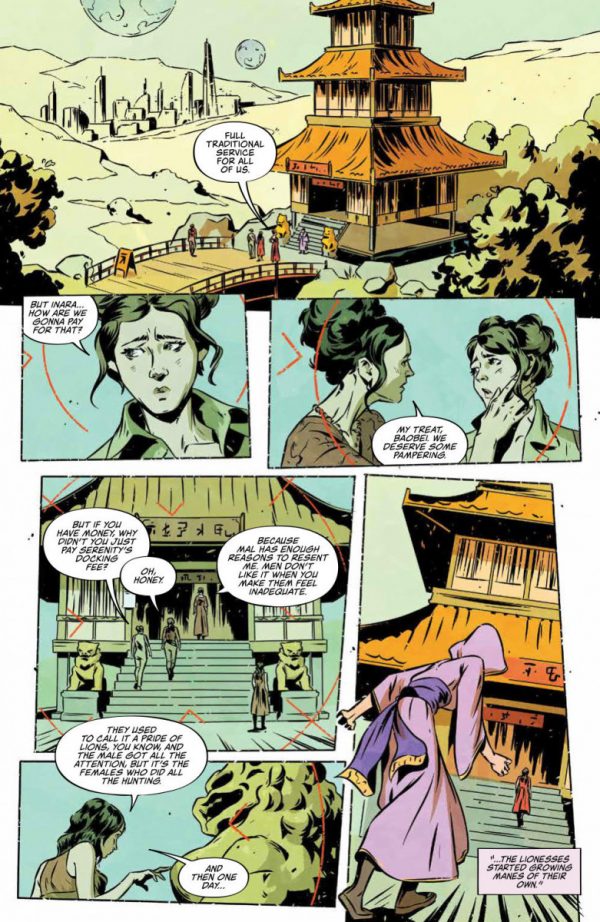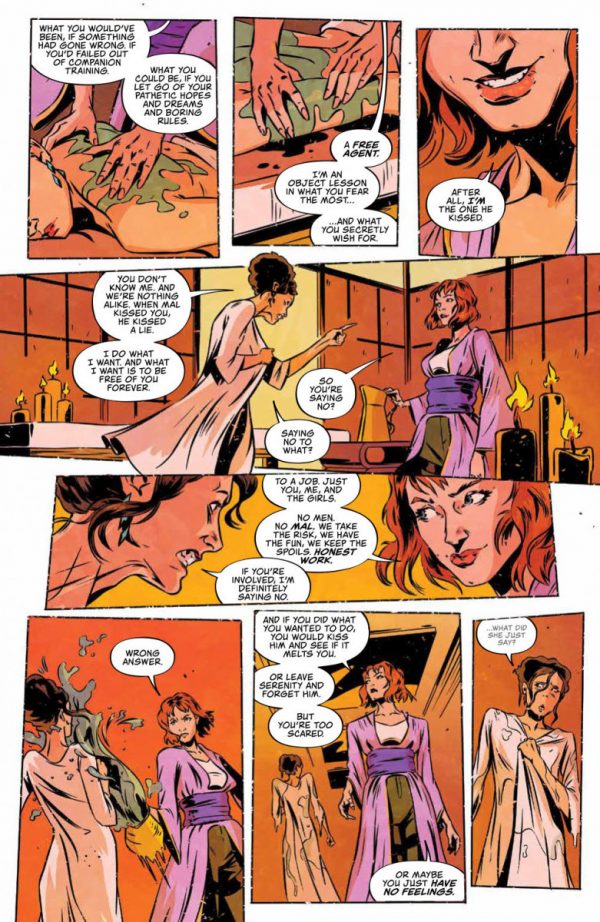
Writer: Delilah S. Dawson
Illustrator: Pius Bak (Chapter 1), Serg Acuna (Chapter 2), Richard Ortiz (Chapter 3), Hyeonjin Kim (Chapter 4), Rodrigo Lorenzo & Richard Ortiz (Chapter 5)
Colors: Joana Lafuente (Chapter 2), Doug Garbark (Chapter 3 & 5), Natalia Marques (Chapter 4)
Lettering: Jim Campbell
Cover By: Marco D’Alfonso
Based on Characters By: Joss Whedon
Publisher: Boom! Studios
Price: $19.99
Available: NOW!!! – Order here!
Out this week from Boom! Studios is the hardcover graphic novel of The Sting, a Firefly tale.
Now, bit of a fair warning on this one, folks: I’m more than a little of a Whedon nut, and have been eagerly checking my Amazon “orders” tab for months (I think I pre-ordered in, like 1974 or so), scanning for The Sting’s delivery date. I will own having yelped like a middle-school girl at a flash sale at the mall when it finally reached my mailbox yesterday. You were warned.
If there’s one thing I’ve learned in a quarter century or so of following the vasty and wonderful darkness that is the Whedonverse, it’s that—despite the activities of nefarious rabbit-molesters at a certain three-letter television studio (yup, still angry)—you can’t stop the signal. As evidenced by the proliferation of successful comics, movies, board/card/RPG/video games, fan fiction and screen productions, let alone the never-ending cosplay, neither Firefly (nor Buffy, Angel or even Dollhouse and the Fray) will ever stop flying.
Thank Joss for that.
At present, Serenity is being piloted by the capable hands at Boom! Studios…and I personally couldn’t be happier.
In The Sting, we’ve got an interesting caper side-story featuring the ubiquitous Yo-Saff-Bridge and her cadre of not-terribly-happy-to-participate female compatriots. To what should be the shock of absolutely no one who’s ever read or watched the series, Saffron has once again infiltrated her way into the world of Serenity…and she aims to misbehave. This time, though, she’s not set her sights on Mal, or any of the other boys. Rather, she’s targeting a gigantic diamond, an exclusive convent, and the ladies of everyone’s favorite Firefly-class spacecraft. And if she can prevail upon a healthy dose of vengeance on the way? Well, she’s not one to complain.

The Sting follows an interesting format wherein each chapter is presented from the point-of-view of a different one of the five protagonists of the tale (ok, four protagonists and one very-antagonist). All of the thought boxes for that chapter refer to that character’s perspective, and each explores, via those thoughts(and, elsewise, via that character’s overt interactions with others), a point of crisis for that character—all of which provides us a well-structured and deeply-layered story which, for all that, is a comfortable read. It’s a highly effective device, especially for a cast as rich as Firefly. Kudos to Dawson on that achievement, and every bit as much for her ability to maintain the independent voices of said cast, as well.

Aiding in that differentiation is the between-issue “prop pieces,” bits of journal entries and recordings which serve to…well, you’ll find out later. Suffice to say, they are specific to each character and their particular crisis. They also serve as a nice opportunity for Campbell to shine, as the handwriting is a reflection of the character who wrote it, and gives us a little more insight into that character. Again, a nice and very effective device.
Typically, I’m not a fan of changing artists one issue/chapter to the next of a dedicated storyline; I tend to find it disruptive to the flow of the experience as my eye adjusts to the new style and line. In The Sting, with Dawson’s changing perspective, it actually works for me: we’re seeing the world through the eyes of a different character each chapter, and so it flows that that world would appear slightly different. And to be clear, we’re not talking Picasso to da Vinci kinds of changes in style, either: there’s a shift, certainly, but not a jarring one. And the changing colorists ease right along with the shifting perspectives. The team done good.
That having been said, I’m always a little leery of reading a comic based a video medium, be that movie or television program. It’s hard enough to capture a character’s voice in literature (and Dawson does it quite well); so much more challenging to capture the cast’s essence and movement. You’re not just drawing a still-life, a posed portrait, you’re having to capture this widely-adored and recognized three-dimensional figure in movement, often in position different than anything that was presented on-screen. Look to some of the Marvel movie adaptations from the ‘80’s for how horribly wrong that can go.
Thankfully, like the work of Georges Jeanty and Will Conrad among a host of others, Bak, Acuna, Ortiz, Lorenzo and Kim don’t disappoint. Again, they each have their own slightly different take, but all more than capably portray our beloved subjects. Inara has her characteristic grace, Zoe her tough-as-nails gruffness, Kaylee is sweet as a summer strawberry, and River is…well, she’s still River.
And I’d be remiss if I didn’t mention how shiny the book itself is. Peppered with a select varnish overlay on front and back, D’Alfonso’s cover, featuring varying-colored panels of the ladies featured within, is—like said damsels—gorram purty. Looks reminiscent of a ‘60’s Ian Fleming novel cover, and is a more than welcome addition to my shelf.
Firefly: The Sting is available now, via Amazon (which is where I got mine, at a nice discount!), from your local comic vendor or on Comixology.
Score: 12/13
Review by Andy Patch, thePullbox.com
